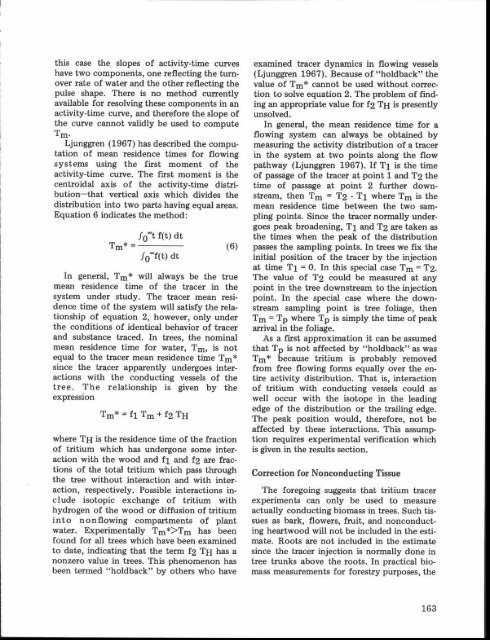PE EIE[R-Rg RESEARCH ON - HJ Andrews Experimental Forest
PE EIE[R-Rg RESEARCH ON - HJ Andrews Experimental Forest
PE EIE[R-Rg RESEARCH ON - HJ Andrews Experimental Forest
You also want an ePaper? Increase the reach of your titles
YUMPU automatically turns print PDFs into web optimized ePapers that Google loves.
this case the slopes of activity-time curve s<br />
have two components, one reflecting the turn -<br />
over rate of water and the other reflecting the<br />
pulse shape. There is no method currently<br />
available for resolving these components in a n<br />
activity-time curve, and therefore the slope of<br />
the curve cannot validly be used to compute<br />
Tm .<br />
Ljunggren (1967) has described the compu -<br />
tation of mean residence times for flowin g<br />
systems using the first moment of th e<br />
activity-time curve. The first moment is th e<br />
centroidal axis of the activity-time distribution-that<br />
vertical axis which divides th e<br />
distribution into two parts having equal areas .<br />
Equation 6 indicates the method :<br />
f0`°t f(t) dt<br />
Tm* _ (6)<br />
f ff(t) dt<br />
In general, Tm* will always be the tru e<br />
mean residence time of the tracer in th e<br />
system under study . The tracer mean residence<br />
time of the system will satisfy the relationship<br />
of equation 2, however, only under<br />
the conditions of identical behavior of trace r<br />
and substance traced . In trees, the nominal<br />
mean residence time for water, Tm, is no t<br />
equal to the tracer mean residence time Tm *<br />
since the tracer apparently undergoes interactions<br />
with the conducting vessels of the<br />
tree . The relationship is given by the<br />
expression<br />
Tm *=f 1 Tm +f2 TH<br />
where TH is the residence time of the fractio n<br />
of tritium which has undergone some interaction<br />
with the wood and fl and f2 are fractions<br />
of the total tritium which pass throug h<br />
the tree without interaction and with inter -<br />
action, respectively . Possible interactions include<br />
isotopic exchange of tritium wit h<br />
hydrogen of the wood or diffusion of tritiu m<br />
into non flowing compartments of plant<br />
water. <strong>Experimental</strong>ly Tm*>Tm has been<br />
found for all trees which have been examine d<br />
to date, indicating that the term f2 TH has a<br />
nonzero value in trees . This phenomenon has<br />
been termed "holdback" by others who have<br />
examined tracer dynamics in flowing vessels<br />
(Ljunggren 1967) . Because of "holdback" the<br />
value of Tm* cannot be used without correction<br />
to solve equation 2 . The problem of finding<br />
an appropriate value for f2 TH is presentl y<br />
unsolved .<br />
In general, the mean residence time for a<br />
flowing system can always be obtained by<br />
measuring the activity distribution of a trace r<br />
in the system at two points along the flow<br />
pathway (Ljunggren 1967) . If Ti is the time<br />
of passage of the tracer at point 1 and T2 the<br />
time of passage at point 2 further down -<br />
stream, then Tm = T2 - Ti where Tm is the<br />
mean residence time between the two sampling<br />
points. Since the tracer normally undergoes<br />
peak broadening, Ti and T2 are taken as<br />
the times when the peak of the distributio n<br />
passes the sampling points . In trees we fix th e<br />
initial position of the tracer by the injectio n<br />
at time Ti = O . In this special case Tm = T2 .<br />
The value of T2 could be measured at an y<br />
point in the tree downstream to the injection<br />
point. In the special case where the downstream<br />
sampling point is tree foliage, the n<br />
Tm = Tp where Tp is simply the time of pea k<br />
arrival in the foliage .<br />
As a first approximation it can be assumed<br />
that Tp is not affected by "holdback" as was<br />
Tm* because tritium is probably remove d<br />
from free flowing forms equally over the en -<br />
tire activity distribution . That is, interactio n<br />
of tritium with conducting vessels could a s<br />
well occur with the isotope in the leadin g<br />
edge of the distribution or the trailing edge .<br />
The peak position would, therefore, not b e<br />
affected by these interactions . This assumption<br />
requires experimental verification whic h<br />
is given in the results section .<br />
Correction for Nonconducting Tissue<br />
The foregoing suggests that tritium trace r<br />
experiments can only be used to measur e<br />
actually conducting biomass in trees . Such tissues<br />
as bark, flowers, fruit, and nonconducting<br />
heartwood will not be included in the estimate.<br />
Roots are not included in the estimate<br />
since the tracer injection is normally done i n<br />
tree trunks above the roots . In practical biomass<br />
measurements for forestry purposes, th e<br />
163








